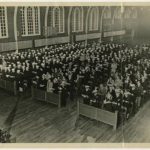Yom Kippur in the NJWB Records
by Rachel Rudman, M.A., Reference Services Research Intern, Center for Jewish History
This post is part of the Holiday History Series. To view all posts in the series, click here.
Above image: Text on back of photograph reads, “Yom Kippur services at Great Lakes, Ill. I think 1942 or 1943. Rabbi Julius Mark was chaplain. Services held in drill hall, now Catholic chapel.” c/o American Jewish Historical Society.
I wrote my last post on sermons and bulletins specific to Rosh Hashanah. Now I will explore a few examples from Yom Kippur announcements. Like the previous examples, these again highlight events most concerning to American Jewish communities as well as the ways in which Jewish leaders connected such events to the Days of Awe. The materials come from records of the National Jewish Welfare Board (NJWB), housed in the American Jewish Historical Society collections here at the Center for Jewish History.
The first example is an excerpt from a sermon delivered on Yom Kippur 1943 titled “The Jew and the Draft.” Doctor Rabbi A. Herbert Fedder of Laurelton Jewish Center begins his speech with a joke popular at the time: “What goes faster than a P-40? A Jew passing a draft board.” His sermon is devoted to debunking the myth that Jews avoid the draft in larger proportions than the rest of the American population, and arming Jews with facts that they can use to answer such a charge. After explaining common reasons Jews have been associated with avoiding the draft, Rabbi Fedder gives numerical evidence of Jewish involvement in the army at a proportion greater than that of other Americans. He calls for Jews to read, analyze, memorize and repeat the great contribution of the Jewish community to the American army. (AJHS I-337, subgroup 1, series C, subseries 4, box 168, Folder 10. Click here for the finding aid.)
Another example can be seen in a letter from Rabbi Manning Bleich addressed to the worshippers of Ohev Sholom Synagogue in Lewistown, Pennsylvania. Before the penitential period of Rosh Hashanah and Yom Kippur in 1945, Rabbi Bleich wrote that while arms have been laid down, the community should approach the Days of Awe with no less meaningful prayer than in previous years. True penitence can help return the world to peace and alleviate suffering of Jews everywhere. He dedicated his Slichot service that year (a service of prayers for forgiveness said before Rosh Hashanah and Yom Kippur) to Lieutenant Louis Krentzman, the first member of his congregation to fall “for G-d and Country.” He called for the pews to be filled in order to honor this brave soldier’s memory. By dedicating the Slichot service to a fallen member of his congregation, Rabbi Bleich both incorporated the realities of WWII into his High Holiday agenda and made the Days of Awe more relevant to his community. (AJHS I-337, subgroup 1, series C, subseries 4, box 168, Folder 10. Click here for the finding aid.)
A final example comes from a statement by Frank Weil, the President of the National Jewish Welfare Board in September 1945. Echoing the message of Rabbi Bleich, Weil expresses the feeling of hope for the Jewish community that accompanies the downfall of the tyrannical regimes in Europe. He commits the NJWB to relief and rehabilitation of displaced survivors of the war and reconstruction of Jewish communities abroad. He calls for prayer on these High Holidays—for Jews in America and for soldiers in Europe and the Far East—to be focused on the historic task of world peace, put forth by the prophets and proclaimed as the goal of mankind. In his message, Weil reveals the contemporary interest of the American Jewish community in supporting the rebuilding and revitalization of the Jewish people in Europe. (AJHS I-337, subgroup 1, series C, subseries 4, box 168, Folder 11. Click here for the finding aid.)
Check back for children’s quizzes on the High Holidays, and a look into historic Jewish communities through Sukkot bulletins and sermons!

